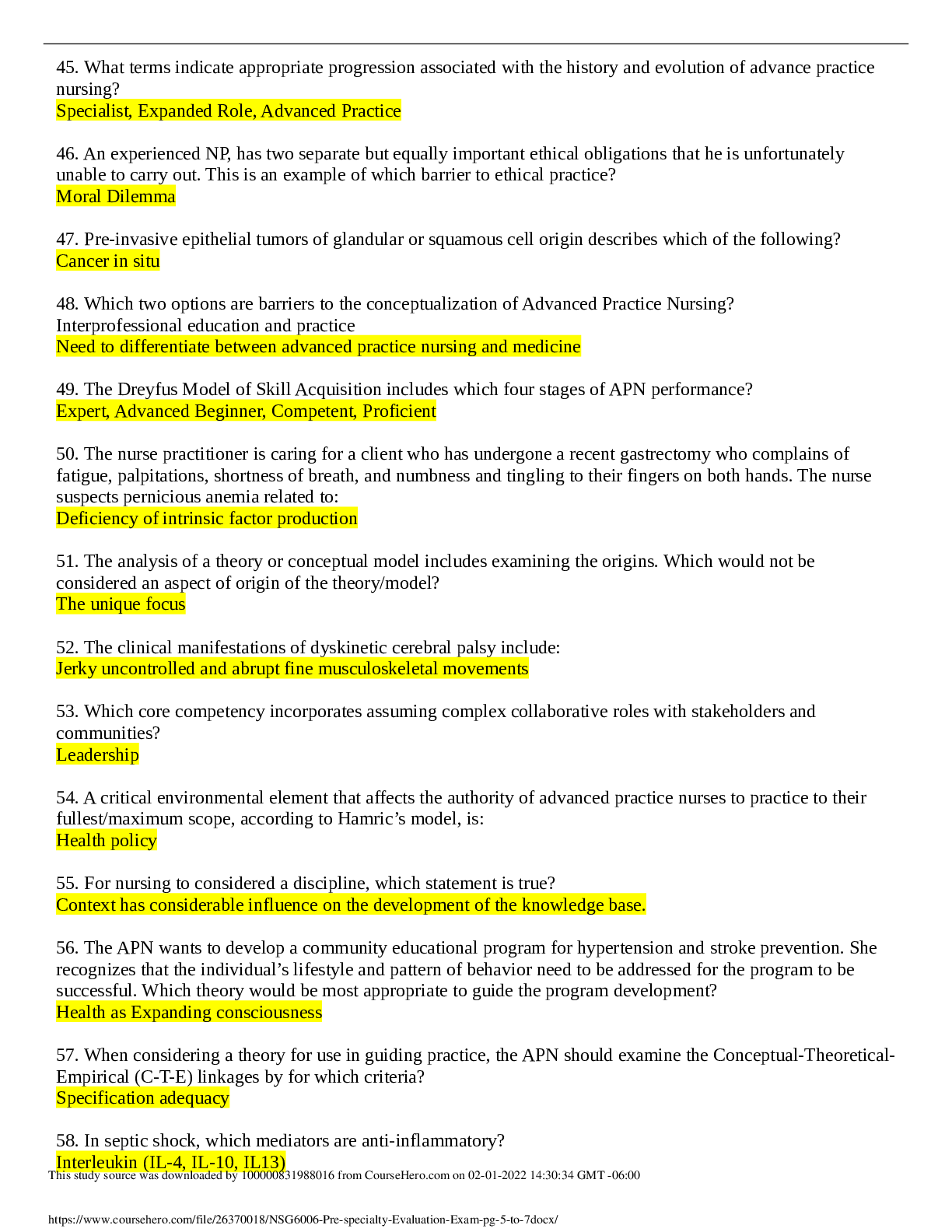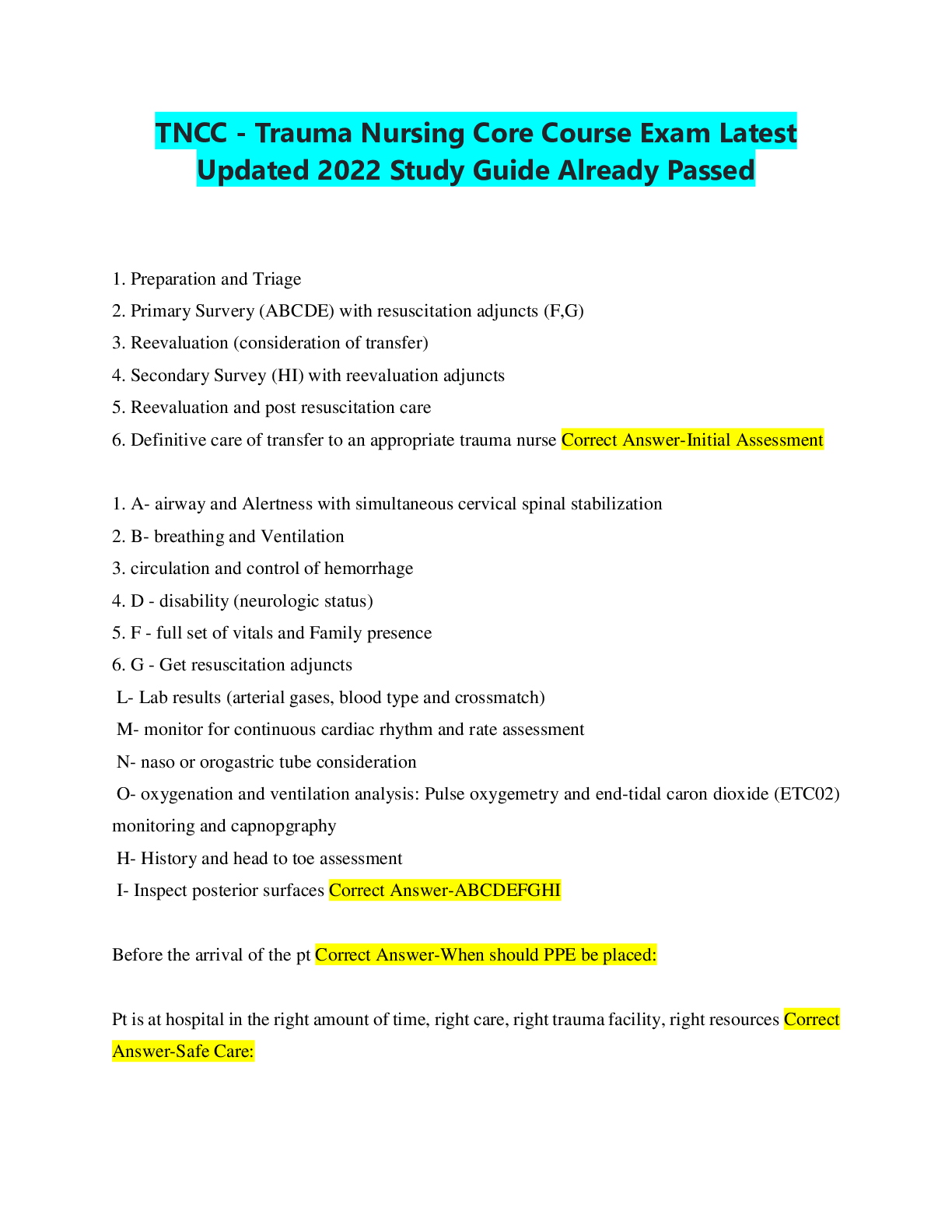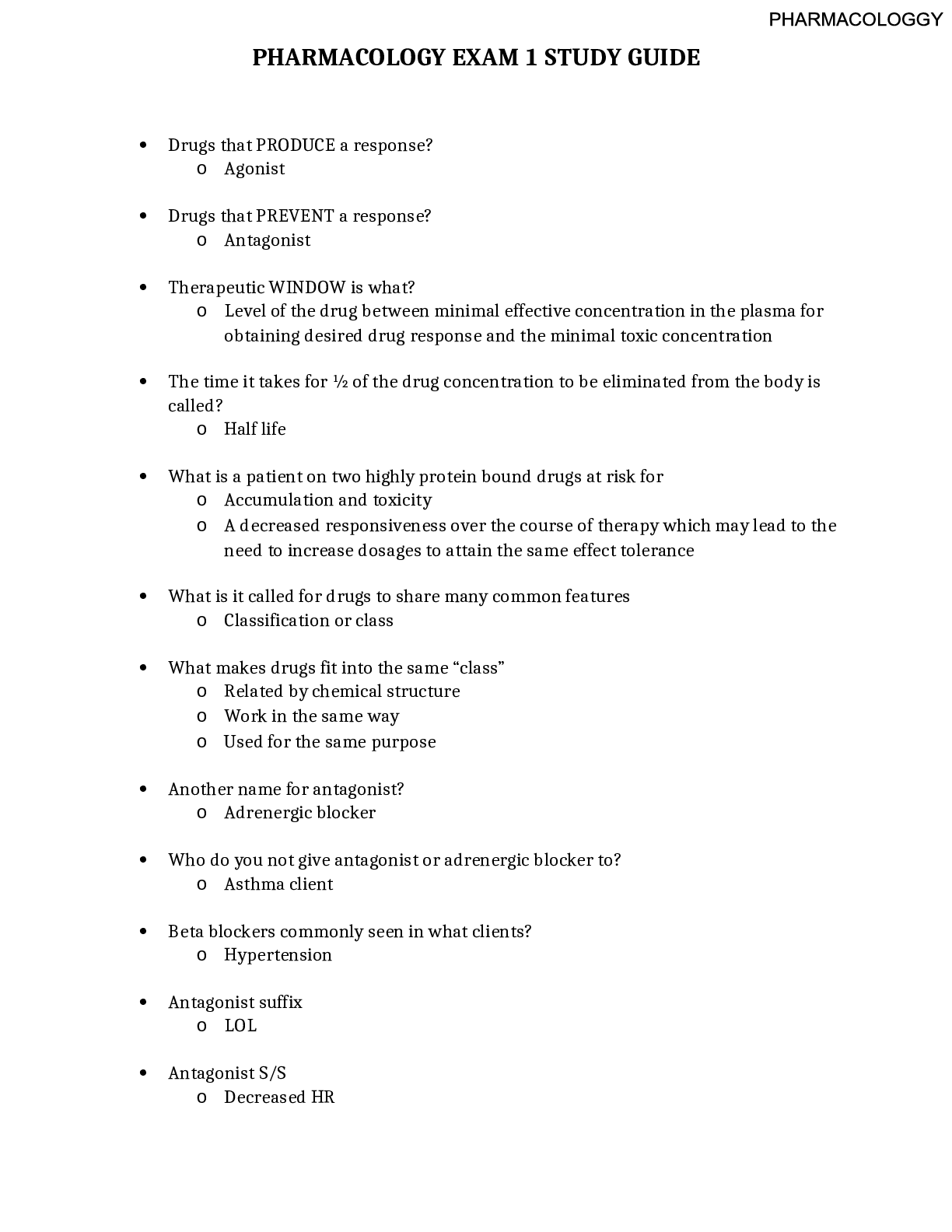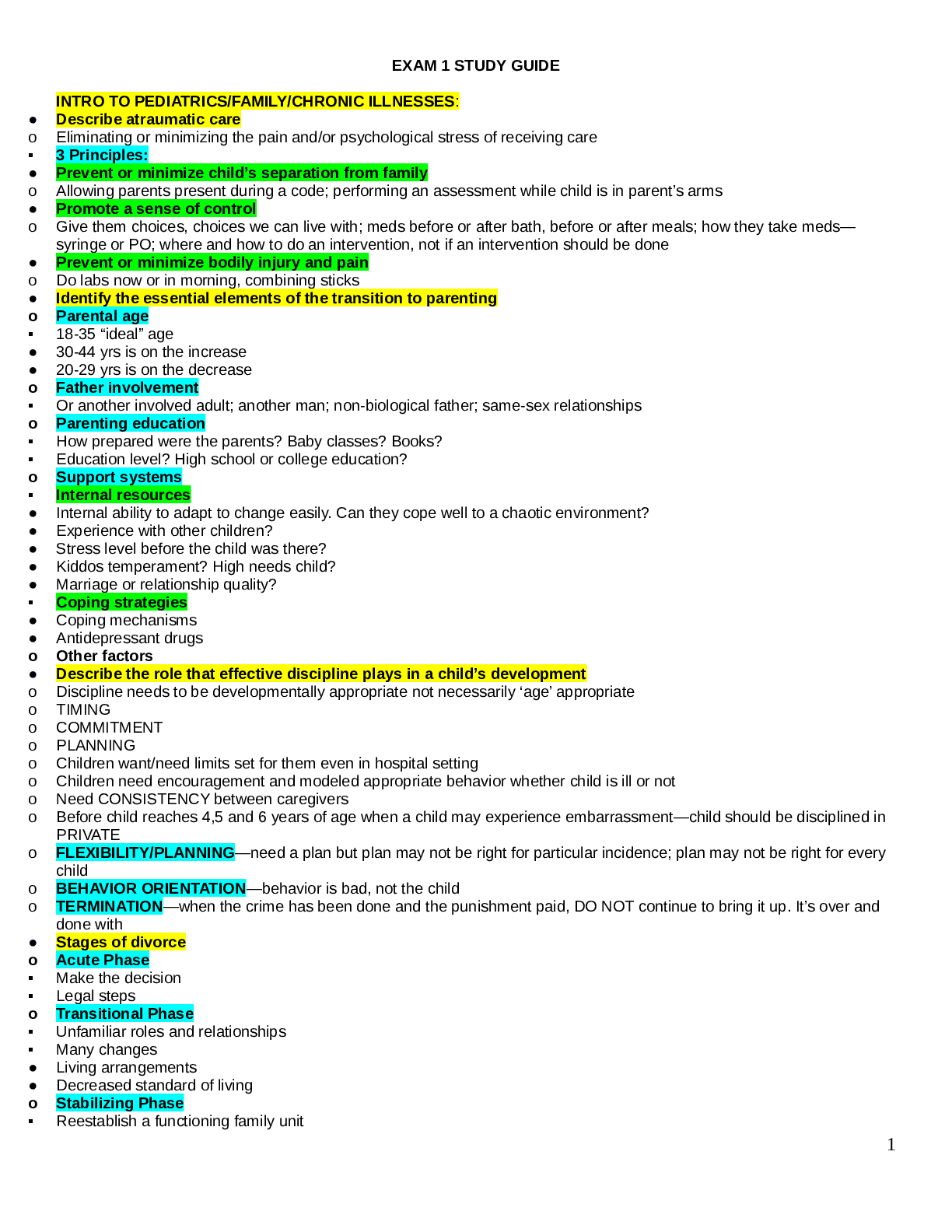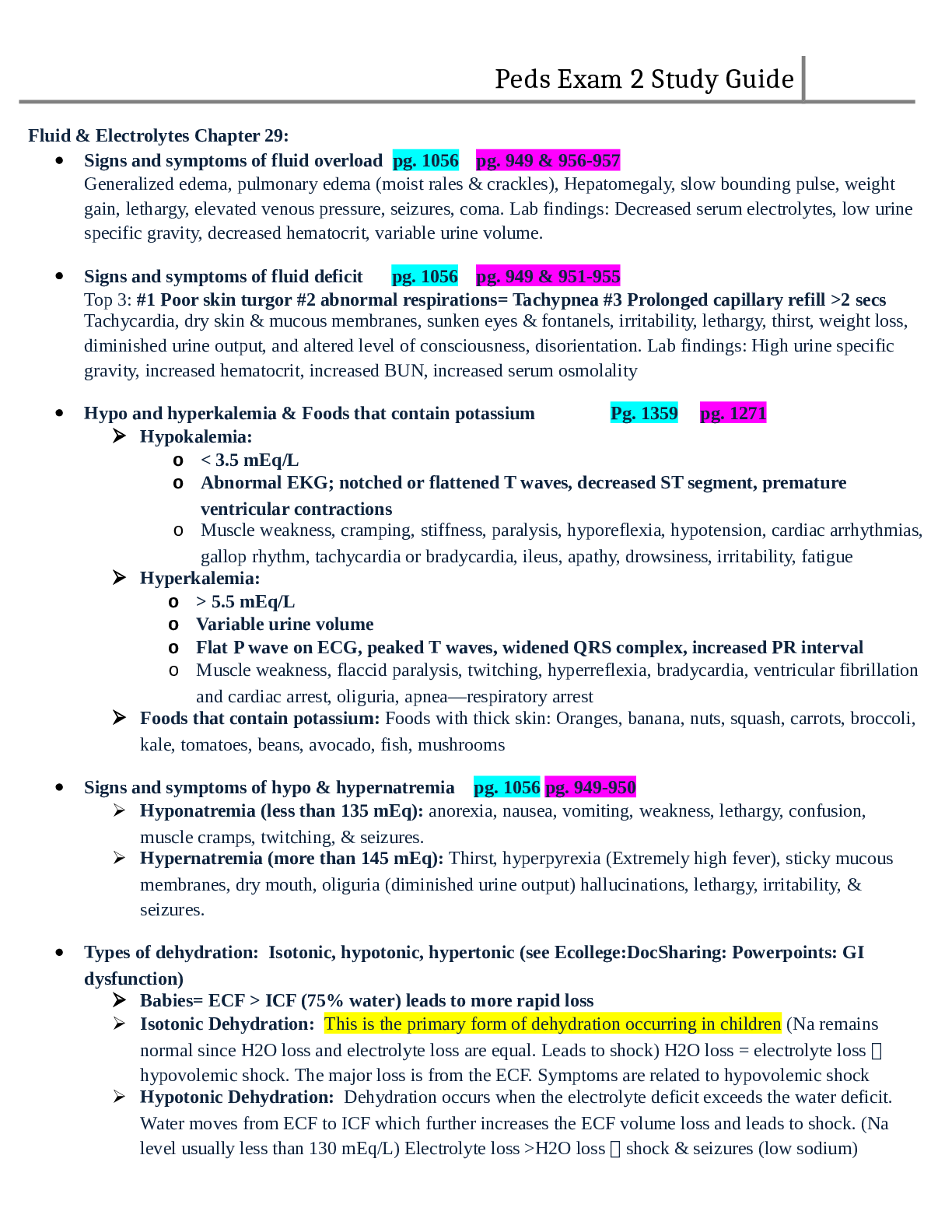*NURSING > STUDY GUIDE > NR 509 Midterm Best Study Guide Ever to Boost your Grades Download Now (All)
NR 509 Midterm Best Study Guide Ever to Boost your Grades Download Now
Document Content and Description Below
● Basic and Advanced Interviewing Techniques Basic Interviewing Techniques ● Active listening: Active listening means closely attending to what the patient is communicating, connecting to the p... atient's emotional state, and using verbal and nonverbal skills to encourage the patient to expand on his or her feelings and concerns. Empathic responses: Empathy has been described as the capacity to identify with the patient and feel the patient's pain as your own, then respond in a supportive manner. Guided questioning: Guided questions show your sustained interest in the patient's feelings and deepest disclosures and allows the interviewer to facilitate full communication, in the patient's own words, without interruption. Nonverbal communication: Nonverbal communication includes eye contact, facial expression, posture, head position and movement such as shaking or nodding, interpersonal distance, and placement of the arms or legs—crossed, neutral, or open. Validation: Validation helps to affirm the legitimacy of the patient's emotional experience. Reassurance: Reassurance is an appropriate way to help the patient feel that problems have been fully understood and are being addressed. Partnering: When building rapport with patients, express your commitment to an ongoing relationship. Summarization: Giving a capsule summary of the patient's story during the course of the interview to communicate that you have been listening carefully. Transitions: Inform your patient when you are changing directions during the interview. Empowering the patient: Empower patients to ask questions, express their concerns, and probe your recommendations in order to encourage them to adopt your advice, make lifestyle changes, or take medications as prescribed. Advanced Interview Techniques 2 Determine scope of assessment: Focused vs. Comprehensive: Comprehensive: Used patients you are seeing for the first time in the office or hospital. Includes all the elements of the health history and complete physical examination. Is appropriate for new patients in the office or hospital Provides fundamental and personalized knowledge about the patient Strengthens the clinician–patient relationship Helps identify or rule out physical causes related to patient concerns Provides a baseline for future assessments Creates a platform for health promotion through education and counseling Develops proficiency in the essential skills of physical examination Focused: For patients you know well returning for routine care, or those with specific “urgent care” concerns like sore throat or knee pain. You will adjust the scope of your history and physical examination to the situation at hand, keeping several factors in mind: the magnitude and severity of the patient’s prob- lems; the need for thoroughness; the clinical setting—inpatient or outpatient, primary or subspecialty care; and the time available. Is appropriate for established patients, especially during routine or urgent care visits Addresses focused concerns or symptoms Assesses symptoms restricted to a specific body system Applies examination methods relevant to assessing the concern or problem as thoroughly and carefully as possible Being aware of your reactions helps develop your clinical skills. Your success in eliciting the history from different types of patients grows with experience, but take into account your own stressors, such as fatigue, mood, and overwork. Self-care is also important in caring for others. Even if a patient is challenging, always remember the importance of listening to the patient and clarifying his or her concerns. Components of the Health History Initial information Date and time of history-time is especially important in emergent situations Identifying data-age, gender, marital status, occupation-identify source of history ie: family member, friend etc. Reliability-usually documented at end of interview ie: “patient is vague when describing symptoms”. Chief Complaint(s) Try to quote the patients words Present Illness Complete, clear and chronological description of the problem prompting the patient visit Onset, setting in which it occurred, manifestations and any treatments 3 Should include 7 attributes of a symptom: Location Quality Quantity or severity Timing, onset, duration, frequency Setting in which it occurs Aggravating or relieving factors Associated manifestations Differential diagnosis is derived from the “pertinent positives” and “pertinent negatives” when doing Review of Systems that are relevant to the chief complaint. Present illness should reveal patient’s responses to his or her symptoms and what effect this has on their life. Each symptom needs its own paragraph and a full description. Medication should be documented, name, dose, route, and frequency. Home remedies, nonprescriptions drugs, vitamins, mineral or herbal supplements, oral contraceptives, or borrowed medications. Allergies-foods, insects, or environmental, including specific reaction Tobacco use, including the type. If someone has quit, note for how long Alcohol and drug use should always be investigated and is often pertinent to the Presenting Illness. Past history Childhood Illness: measles, rubella, mumps, whooping cough, chickenpox, rheumatic fever, scarlet fever, and polio. Also include any chronic childhood illness Adult illnesses: Provide information in each of the 4 areas: Medical: diabetes, hypertension, hepatitis, asthma and HIV; hospitaliations; number and gender of sexual partners; and risk taking sexual practices. Surgical: dates, indications, and types of operations Obstetric/gynecologic: Obstetric history, menstrual history, methods of contraception, and sexual function. Psychiatric: Illness and time frame, diagnoses, hospitalizations, and treatments. Health Maintenance: Find out if they are up to date on immunizations and screening tests. 4 Family history Outlines or diagrams age and health, or age and cause of death, of siblings, parents, and grandparents Documents presence or absence of specific illnesses in family, such as hypertension, coronary artery disease, elevated cholesterol levels, stroke, diabetes, thyroid or renal disease, arthritis, tuberculosis, asthma or lung disease, headache, seizure disorder, mental illness, suicide, substance abuse, and allergies, and symtoms reported by patient. Ask about history of breast, ovarian, colon, or prostate cancer Ask about Genetically transmitted diseases Personal or social history Describes educational level, occupation, family of origin, current household, personal interests, and lifestyle Capture the patients personality and interests, sources of support, coping style, strengths, and concerns Includes lifestyle habits that promote health or create risk, such as exercise and diet, safety measures, sexual practices, and use of alcohol, drugs, and tobacco Expanded personal and social history personalizes your relationship with the patient and builds a rapport Review of systems Documents presence or absence of common symptoms related to each of the major body systems Understanding and using Review of Systems questions may seem challenging at first. These “yes-no” questions should come at the end of the interview. Think about asking a series of questions going from “head to toe.” It is helpful to prepare the patient by saying, “The next part of the history may feel like a hundred questions, but it is important to make sure we have not missed anything.” Most Review of Systems questions pertain to symptoms, but on occasion, some clinicians include diseases like pneumonia or tuberculosis. Note that as you elicit the Present Illness, you may also draw on Review of Systems questions related to system(s) relevant to the Chief Complaint to establish “pertinent positives and negatives” that help clarify the diagnosis. For example, after a full description of chest pain, you may ask, “Do you have any history of high blood pressure . . . palpitations . . . shortness of breath . . . swelling in your ankles or feet?” or even move to questions from the Respiratory or Gastrointestinal Review of Systems The Review of Systems questions may uncover problems that the patient has overlooked, particularly in areas unrelated to the Present Illness. Significant 5 health events, such as past surgery, hospitalization for a major prior illness, or a parent’s death, require full exploration. Keep your technique flexible. Remember that major health events discovered during the Review of Systems should be moved to the Present Illness or Past History in your write-up. ■ Some experienced clinicians do the Review of Systems during the physical examination, asking about the ears, for example, as they examine them. If the patient has only a few symptoms, this combination can be efficient. If there are multiple symptoms, however, this can disrupt the flow of both the history and the examination, and necessary note taking becomes awkward 6 Subjective versus Objective Data Subjective versus Objective Data (pg. 7) 7 Subjective Data (symptoms) Objective Data (signs) What the patient tells you What is observed during physical examination Patients history, from Chief Complaint through Review of Systems Laboratory information, test data Documentation Documentation needs to be CLEAR, CONCISE, COMPREHENSIVE. SOAP (subjective, objective, assessment, & plan) note is used for providers of various backgrounds/specialties to communicate with each other. Ch. 2 1. Clinical Decision Making Critical Thinking and Reasoning Differential Diagnoses Differential Diagnosis: A list with potential causes of patient specific problem/CC • A chief complaint (CC) must be identified first. • The differential diagnosis will include all medical disease that may possibly explain problem/ CC. • The differential diagnosis must include the most likely diagnosis and even at times the most serious diagnoses that have serious consequences if undiagnosed and untreated. • The differential diagnosis list should begin with the most likely explanation or etiology for the problem/CC. EX: C/O vomiting blood 1. Peptic ulcer 2. Cirrhosis with bleeding esophageal varices 3. Acute hemorrhagic gastritis [Show More]
Last updated: 2 years ago
Preview 1 out of 39 pages

Buy this document to get the full access instantly
Instant Download Access after purchase
Buy NowInstant download
We Accept:

Reviews( 0 )
$9.50
Can't find what you want? Try our AI powered Search
Document information
Connected school, study & course
About the document
Uploaded On
Aug 05, 2021
Number of pages
39
Written in
Additional information
This document has been written for:
Uploaded
Aug 05, 2021
Downloads
0
Views
116




